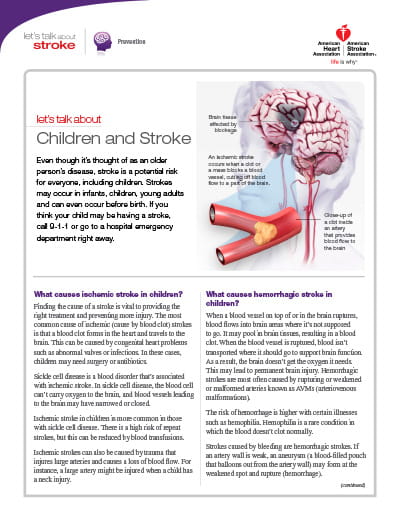Let’s Talk About Children and Stroke
 Even though it’s thought of as an older person’s disease, stroke is a potential risk for everyone, including children. Strokes may occur in infants, children, young adults and can even occur before birth. If you think your child may be having a stroke, call 911 or go to a hospital emergency department right away.
Even though it’s thought of as an older person’s disease, stroke is a potential risk for everyone, including children. Strokes may occur in infants, children, young adults and can even occur before birth. If you think your child may be having a stroke, call 911 or go to a hospital emergency department right away.
What causes ischemic stroke in children?
Finding the cause of a stroke is vital to providing the right treatment and preventing more injury. The most common cause of ischemic (cause by blood clot) strokes is that a blood clot forms in the heart and travels to the brain. This can be caused by congenital heart problems such as abnormal valves or infections. In these cases, children may need surgery or antibiotics.
Sickle cell disease is a blood disorder that’s associated with ischemic stroke. In sickle cell disease, the blood cell can’t carry oxygen to the brain, and blood vessels leading to the brain may have narrowed or closed.
Ischemic stroke in children is more common in those with sickle cell disease. There is a high risk of repeat strokes, but this can be reduced by blood transfusions.
Ischemic strokes can also be caused by trauma that injures large arteries and causes a loss of blood flow. For instance, a large artery might be injured when a child has a neck injury.
What causes hemorrhagic stroke in children?
When a blood vessel on top of or in the brain ruptures, blood flows into brain areas where it’s not supposed to go. It may pool in brain tissues, resulting in a blood clot. When the blood vessel is ruptured, blood isn’t transported where it should go to support brain function. As a result, the brain doesn’t get the oxygen it needs. This may lead to permanent brain injury. Hemorrhagic strokes are most often caused by rupturing or weakened or malformed arteries known as AVMs (arteriovenous malformations).
The risk of hemorrhage is higher with certain illnesses such as hemophilia. Hemophilia is a rare condition in which the blood doesn’t clot normally.
Strokes caused by bleeding are hemorrhagic strokes. If an artery wall is weak, an aneurysm (a blood-filled pouch that balloons out from the artery wall) may form at the weakened spot and rupture (hemorrhage).
Will my child get better?
Recovery from stroke is different with each child. Prompt medical treatment and rehabilitation therapy can maximize recovery. In general, most young people will recover more abilities than older people will. Children often recover the use of their arms and legs and their ability to speak after a stroke.
What are the effects of stroke in children?
The effects of stroke in a child are generally the same as in an adult. The most common effects are:
- Weakness on one side of the body, or paralysis on one side of the body.
- One-sided neglect, which causes stroke survivors to ignore or forget their weaker side (usually related to a right-brain stroke, causing left-sided neglect).
- Difficulty with speech and language or trouble swallowing.
- Decreased field of vision and trouble with visual perception.
- Loss of emotional control and changes in mood.
- Cognitive changes or problems with memory, judgment and problem-solving.
- Behavior changes or personality changes, improper language or actions.
How can I learn more?
- Call 1-888-4-STROKE (1-888-478-7653) or visit stroke.org to learn more about stroke or find local support groups.
- Sign up to get Stroke Connection magazine, a free magazine for stroke survivors and caregivers, at StrokeConnection.org.
- Connect with others sharing similar journeys with stroke by joining our Support Network at stroke.org/SupportNetwork.
Do you have questions for the doctor or nurse?
Take a few minutes to write your questions for the next time you see your healthcare provider. For example:
Are the tests harmful to my child?
What can be done to prevent another stroke?
We have many other fact sheets to help you make healthier choices to reduce your risk, manage disease or care for a loved one.
Visit stroke.org/LetsTalkAboutStroke to learn more
©2015, American Heart Association